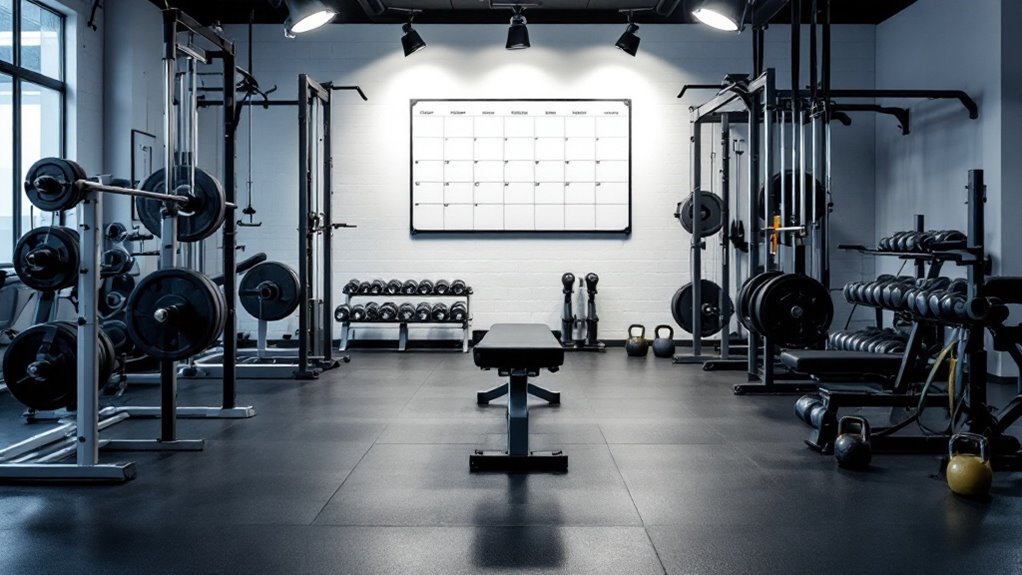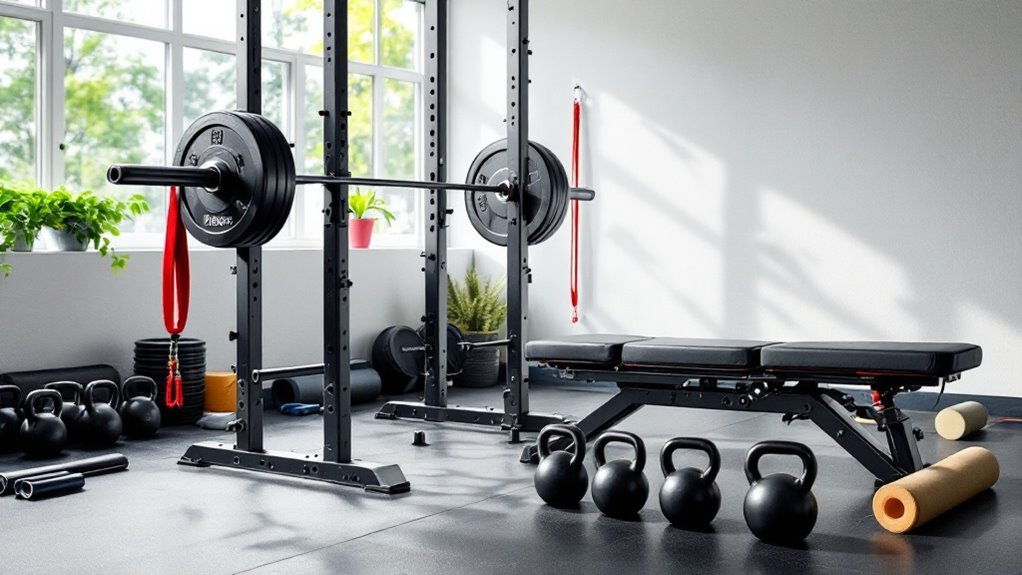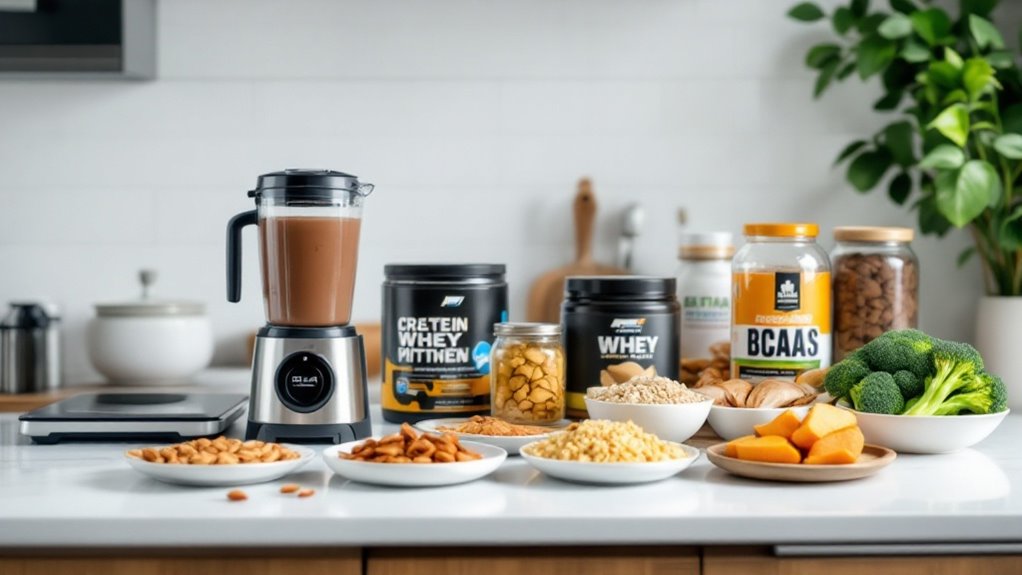Best Workout Routine for Muscle Gain

Building muscle effectively requires three key components: proper resistance training, strategic nutrition, and adequate recovery. The most effective routines combine compound movements like squats, deadlifts, and bench presses with isolation exercises, performed 3-6 times weekly depending on experience level. A progressive overload approach guarantees continuous gains, while consuming 1.6-2.2g of protein per kg of body weight supports muscle growth. Understanding the science behind muscle development opens the path to maximum results.
Key Takeaways
- Follow a structured training split of 3-4 days per week, focusing on compound exercises like squats, deadlifts, and bench presses.
- Maintain progressive overload by gradually increasing weights, reps, or sets to continuously challenge muscles and prevent plateaus.
- Consume adequate protein (1.6-2.2g per kg bodyweight) and balanced nutrients to support muscle growth and recovery.
- Focus on proper form and control during exercises, emphasizing full range of motion over lifting heavier weights.
- Allow sufficient recovery time between workouts and prioritize quality sleep for optimal hormone release and muscle repair.
The Science Behind Muscle Growth and Recovery

Building muscle is a complex biological process that occurs through a combination of mechanical tension, metabolic stress, and muscle damage. When muscles experience these stressors during resistance training, microscopic tears form in the muscle fibers, triggering a cascade of cellular responses.
During the recovery phase, the body activates satellite cells that fuse with damaged muscle fibers, forming new protein strands. This process, called muscle protein synthesis, requires adequate protein intake and rest. Growth hormones and testosterone levels peak during sleep, making proper recovery essential.
The key is maintaining a balance between training intensity and recovery time. Too little rest impairs growth, while too much reduces adaptation stimulus. Implementing progressive overload training consistently is crucial for continued muscle development and preventing plateaus.
Designing Your Weekly Training Split

A well-structured weekly training split serves as the foundation for consistent muscle growth and peak performance.
Like a military operation, each training day requires strategic planning to enhance results while allowing adequate recovery.
The most effective splits include push/pull/legs, upper/lower body, or the classic body-part split.
For beginners, a three-day full-body split provides the best frequency and recovery.
More advanced lifters can benefit from a four to six-day split, targeting specific muscle groups with greater volume and intensity.
Key factors in selecting the ideal split include training experience, recovery capacity, and schedule flexibility.
Success comes from choosing a sustainable routine that corresponds with individual goals and lifestyle demands.
Implementing progressive overload principles throughout your training split is essential for continued muscle development and strength gains.
Essential Exercises and Proper Form Techniques

Mastering fundamental exercises forms the cornerstone of any successful muscle-building program. Proper form guarantees optimal muscle involvement while minimizing injury risk. Each movement pattern requires strict attention to technique, breathing, and mind-muscle connection.
- Compound lifts like squats, deadlifts, bench presses, and rows should form the foundation of every workout.
- Maintain neutral spine positioning and activate core muscles throughout each exercise.
- Control the eccentric (lowering) phase of movements to enhance muscle tension.
- Focus on full range of motion rather than lifting heavier weights with poor form.
The effectiveness of any exercise routine depends primarily on execution quality rather than quantity. Implementing progressive overload techniques systematically increases training intensity to ensure continuous strength development over time.
Nutrition and Supplementation for Maximum Gains

Proper nutrition serves as the fundamental fuel that powers muscle growth and recovery. The body requires adequate protein intake, typically 1.6-2.2 grams per kilogram of body weight daily, along with balanced carbohydrates and healthy fats to support muscle development.
Key supplements that can improve muscle gains include whey protein, creatine monohydrate, and essential amino acids. Timing these supplements strategically around workouts optimizes their effectiveness.
Pre-workout meals should focus on complex carbohydrates and lean proteins.
Post-workout nutrition demands fast-absorbing proteins and simple carbs to jumpstart recovery. Staying hydrated and maintaining consistent meal timing throughout the day creates the ideal environment for muscle growth.
Following the principle of progressive overload helps ensure continuous muscle development when combined with proper nutrition.
Frequently Asked Questions
How Long Should I Wait Between Sets to Maximize Muscle Growth?
Research shows ideal rest periods between sets should be 2-3 minutes for compound exercises and 1-2 minutes for isolation movements.
This timing allows proper ATP replenishment while maintaining workout intensity. Going too short reduces performance, while excessive rest diminishes the metabolic stress needed for hypertrophy.
Rest periods can be adjusted based on exercise intensity and individual recovery capacity.
Can I Build Muscle Effectively if I'm Training at Home Without Equipment?
While couch potatoes dream of magically growing muscles by binge-watching Netflix, the reality is that bodyweight exercises can build impressive strength.
Progressive calisthenics like push-ups, pull-ups, dips, and squats effectively stimulate muscle growth through resistance and proper form. The key is increasing difficulty through variations, higher reps, and slower tempos.
Advanced moves like handstand push-ups and pistol squats can rival weighted exercises for muscle development.
Should I Train When Feeling Slight Muscle Soreness From Previous Workouts?
Training with mild muscle soreness, known as DOMS (Delayed Onset Muscle Soreness), is generally safe and can even help reduce discomfort through increased blood flow.
However, severe pain or sharp discomfort signals the need for rest. The key is distinguishing between normal soreness and potential injury.
Light warm-ups will reveal if the body is ready for training. When in doubt, reduce intensity rather than skipping workouts entirely.
Is It Better to Lift Heavier Weights or Do More Repetitions?
While weightlifters have debated this question since dinosaurs were doing bicep curls, both heavy weights and high repetitions serve different purposes.
Heavy weights (4-6 reps) primarily build strength and muscle density, while higher repetitions (12-15 reps) focus on muscle endurance and definition.
The ideal approach combines both methods through progressive overload, allowing muscles to adapt to various stimuli and prevent plateaus in growth.
How Do I Know When It's Time to Increase the Weight I'm Lifting?
Trainers use the "2-for-2" rule: when someone can perform all prescribed sets and reps with perfect form for two consecutive workouts, it's time to increase weight by 2.5-5%.
Moreover, if the last few reps feel too easy or they're not experiencing muscle fatigue, that's another signal.
Progress should be steady but controlled, always maintaining proper form over rushing to lift heavier.
Final Thoughts
Like a master sculptor shaping raw marble into a masterpiece, building muscle is a delicate balance of stress and recovery. With strategic training splits, fundamental compound movements, and proper nutrition acting as the chisel, anyone can transform their physique. Success lies not in random acts of exercise, but in the disciplined execution of proven methods, turning sweat and dedication into tangible results.


